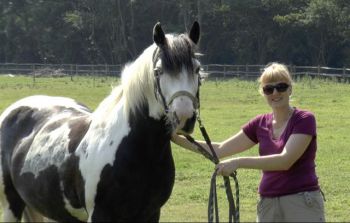Scientists begin to uncover how horses communicate with their faces
By: Jacqui Bealing
Last updated: Friday, 8 August 2014

Jennifer Wathan with Bartie
When it comes to paying attention to each other, it seems that horses are all ears.
A new University of Sussex study has shown that horses use a variety of visual cues to work out what may be going on in a stablemate’s head. And one of the most important factors for communication is the direction of a horse’s ears.
Mammal communication experts Jennifer Wathan and Professor Karen McComb, whose paper is published on 04 August 2014, set up an experiment to see which cues horses relied on to judge the direction of another horse’s attention in a task where they had to choose where to feed.
Each horse was individually led to a point where it was released and allowed to choose between two buckets. On a wall behind the buckets was a life-sized photograph of a horse’s head facing either to left or right.
The researchers found that if either the ears or the eyes of the horse in the picture were obscured, the horse being led made a random choice between the two buckets. However, if the ears and eyes were visible, then the horse used these directional cues to guide their choice.
Jennifer Wathan says: “Previous work investigating communication of attention has focused on cues that humans use – body orientation, head orientation and eye gaze. But no one had gone beyond that. We found that in horses, their ear position was also a crucial visual signal. In fact, horses needed to see the detailed facial features of both eyes and ears before they would use another horse’s head direction to guide their choice.”
She adds: “Most people who live and work alongside animals with mobile ears would agree that the ears are important in communication, but it has taken science a while to catch up. We naturally have a human-centric view of the world and as we can’t move our ears they get rather overlooked in other species.”
Professor McComb says: "This study emphasises that animals other than primates are aware of subtle differences in facial expression and can use these to guide the decisions that they make. Fine scaled facial movements can indicate important changes in attention and emotional state and are likely to be crucial in determining social behaviour in a wide range of animals."
The researchers’ paper, ‘The eyes and ears are visual indicators of attention in domestic horses’ is published in Current Biology, on 04 August 2014.
You can also read the full published reseasrch on Sussex Research Online.
Notes for editors
Professor Karen McComb is a Director of the University of Sussex’s Mammal Vocal Communication and Cognition Research group.
The study was funded by the Biotechnology and Biological Sciences Research Council (BBSRC)
University of Sussex Press Office: Tel: 01273 678888. Email: press@sussex.ac.uk

